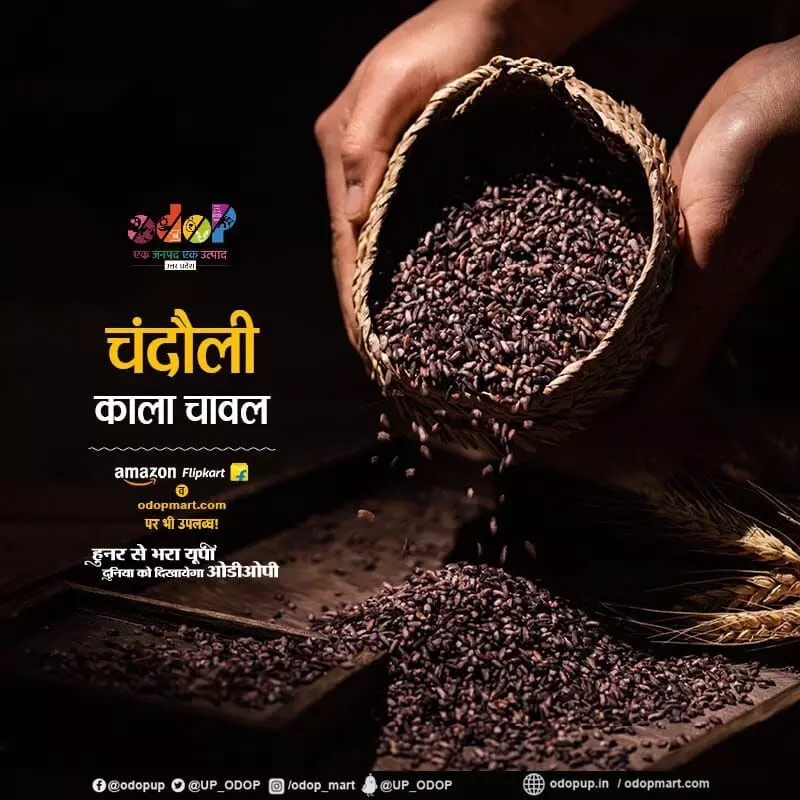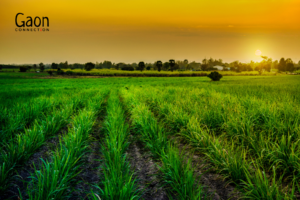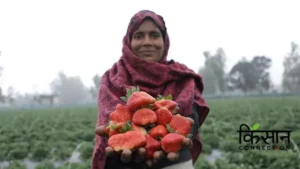Chandauli, Uttar Pradesh
Chandauli in Uttar Pradesh is renowned for the rice it grows. Drained by the Karamnas, Chandraprabha and the Ganges rivers, and a wide network of canals, the fertile plains of the district are lush with paddy fields.
In 2018, paddy cultivation in the district took a new turn, when black rice grains were introduced here for the first time. Under the initiative of the Uttar Pradesh government, they were brought from Manipur in the northeast, where black rice or chakhao as it is locally known there, has been cultivated for years.
Navneet Singh Chahal, who was Chandauli’s district magistrate then, brought 12 kilogrammes (kgs) of black rice seeds from Manipur at a cost of Rs 1,200 per kg and distributed them to 30 paddy farmers.
Pintu Pradhan, from Kanta Jalalpur in Chandauli, was one of the 30 farmers of the pilot project who first grew black rice in Uttar Pradesh. He told Gaon Connection how black rice cultivation looked so promising to the paddy farmers of Chandauli. But not anymore.
“Initially, the going was great. But, now I have unsold black rice lying in my house with rats and squirrels feeding on them. I have not been able to sell it,” the 34-year-old farmer complained. Pradhan said he would start only when its demand picked up and farmers were assured a market.
Also Read: Despite higher MSP at govt procurement centres, farmers prefer selling paddy to private traders
Sashikant Rai, a progressive farmer from Amda village who has been practising agriculture for a decade also spoke of the drastic drop in demand that has led to many farmers giving it up. But, he continues to grow black rice.
The government has done a lot to promote this nutritious variety of black rice from Chandauli. It has been added to the state government’s One District One Product (ODOP) scheme, and has won the Prime Minister’s Excellence Award in 2020-21.
According to data from the agriculture department of Chandauli, 150 kgs of black rice was produced in 2018 and 70 kgs of it was sold at the Prayagraj Kumbh Mela at Rs 70 a kilo. The rest of the rice was retained to be used for the following kharif season in 2019.
Also Read: Kharif paddy lost to drought, no resources to sow rabi wheat, say farmers in Jharkhand
In 2019, the number of black rice farmers in the district increased from 30 to 200 and about 100 hectares of land came under black rice cultivation. That year, 1,129 quintals (1 quintal = 100 kgs) of black rice were harvested. The success of black rice cultivation in Chandauli gathered remarkable momentum, when about 1,600 quintals of the black rice in all (including earlier stocks), was exported to Qatar, Australia, New Zealand, the United Arab Emirates, and some other countries.
In 2020, there were 275 farmers growing black rice and they produced 1,300 quintals of which about 250 quintals were sold to companies in NOIDA, Sonepat and Mirzapur in 2021.

Black rice has been added to the state government’s One District One Product (ODOP) scheme, and has won the Prime Minister’s Excellence Award in 2020-21.
But, the aftermath of the COVID-19 pandemic caught up, and the celebrations over black rice dimmed somewhat. Exports fell, and in 2021 only 500 quintals of rice were produced in the district, which is less than half of what was produced in 2019.
Many of the small and marginal farmers who took up black rice cultivation claim they have been unable to sell their crops. According to Basant Dube, district agriculture officer, Chandauli, there are more than 750 quintals of unsold black rice lying in the Chandauli mandi samiti, and the farmers are yet to be paid for it.
Dhananjay Maurya from Kanta Jalalpur village, who cultivated black rice, has stopped growing it now. “Milling of black rice is a problem. Authorities need to provide medium and small farmers access to proper milling and processing facilities,” he told Gaon Connection. “Many of the small farmers dry the harvested paddy on rooftops or out in the open air. This can lead to the rice having grit and other impurities in them, which is unacceptable to the foreign markets,” he added.
Dhananjay was also waiting for things to look up before he began recultivating black rice.
Also Read: The makhanas of Bihar get a GI tag, but a sudden price crash leaves the farmers in a fix
Black rice makes economic and ecological sense
According to the paddy farmers, cultivation of black rice requires relatively less inputs in terms of fertiliser and irrigation water, and its health benefits. That is the reason it costs more than regular varieties of rice.
“While the minimum support price of regular rice, depending on its variety and quality, goes up to Rs 2,500 per quintal, black rice has in the past sold for as much as Rs 8,000 a quintal and is currently selling at about Rs 5,000 a quintal,” Rai said.
Some farmers are holding on to the hope that the demand for black rice will go up once again.

There are more than 450 farmers who are shareholders of our Chandauli Farmer Producer Company.
“There are more than two dozen of us who are cultivating black rice in this block. It involves less investment, yields well and is cultivated without any chemical inputs,” Ramvilas Maurya from Manikpur Sani village in Barahni block in Chandauli told Gaon Connection.
Also Read: Kashmiri farmers move from paddy fields to apple orchards for higher returns
“When we prepare an acre of land for regular paddy, we use 50 kgs of DAP (Rs 1,320), 25 kgs of urea (Rs 250), 15 kgs of potash (Rs 500), 10 kgs of zinc (Rs 300), and up to a litre and a half of herbicides (Rs 500),” Ramvilas said.
In sharp contrast, according to him, black rice requires no chemical fertilisers and the farmer can save at least Rs 3,000- 4,000 per acre on that. “Those of us who are growing black rice in this block are excited about it, as the rice is chemical-free, involves less expenditure and goes for a good price,” he explained.
“The traditional rice varieties such as mussoorie yield about 17 to 19 quintals per bigha. The black rice yields about 10 quintals from the same area. Still, the profit made on black rice is more than the traditional grain,” Achyutanand Tripathi, a farmer from Kandwa, told Gaon Connection.
“After deducting the cost of investment on cultivating the conventional rices like the musoorie, the profit lies at Rs 16,000 to Rs 17, 000. Whereas a bigha of black rice can fetch the farmer about Rs 70,000 to Rs 80, 000 profit,” Tripathi pointed out.
Black Rice: Healthy and nutritious
The black rice farmers in Chandauli say the rice is bursting with nutrients. “This is no ordinary rice. Black rice has immense medicinal properties beneficial for the human body,” Ratan Singh, a paddy farmer from Sikhtha village in Chandauli, told Gaon Connection.
Ratan Singh listed the benefits of black rice. According to him, the rice was packed with protein, natural fibre, magnesium, iron, vitamin E, calcium, etc protein, iron, vitamin E, calcium, magnesium, natural fibre. “So, a kheer made with black rice, along with it being fragrant and tasty is also nutritious,” the farmer said.
Cancer specialist Sashi Upadhay from Shri Shiv Prasad Gupt Divisional District Hospital in Kabir Chaura, Varanasi, endorsed the health benefits of black rice.
“It is nutritious and ideal for people of all ages to consume,” he told Gaon Connection.
According to the oncologist, black rice had a lot more fibre, minerals and vitamins when compared to the conventional rice. “It is rich in antioxidants, and has anti-inflammatory and anti-cancer properties. The carotenoid content in the rice is good for eye health and medical research is pointing at its health benefits that could help cancer patients, too,” Upadhyah added. The coating on the black rice has Anthocyanins that gives the grain its black colour, he added.
Promoting black rice
Progressive farmer Rai felt that government intervention would go a long way in raising awareness and promoting production of black rice both in the state and across the country.
The government should promote the use of black rice as a health-giving grain. Some of the ways that can be done is by really pushing the consumption locally, he said.
“Black rice khichdi can be served to patients in the hospitals. FPOs [farmers producers organisations] can make chivda, laddoos and other value added products from black rice,” Rai suggested.
There is already an FPO that is trying to promote black rice. “There are more than 450 farmers who are shareholders of our Chandauli Farmer Producer Company. The FPO provides the farmers who are cultivating black rice, technical know-how, seeds and marketing platforms,” Virendra Singh, a farmer member of the FPO told Gaon Connection.
The members of the FPO (there are 15 FPOs in Chandauli) are eligible for several schemes introduced by the government such as financial help, technical assistance and good quality seeds, he added.

Black rice requires no chemical fertilisers and the farmer can save at least Rs 3,000- 4,000 per acre.
“Recently, under the ODOP scheme, farmers were given a 10-day training that included the best way to set up nurseries, taking care of the crop, crop cutting and how to market it well,” said Virendra Singh.
Also Read: Paddy rots as an overflowing effluent drain inundates farmlands in 13 villages of Unnao, UP
If the government extended support to distribute black rice widely, it would be beneficial both to farmers as well as consumers, Ratan Singh pointed out.
“I request the prime minister and our chief minister to direct the public distribution system to give black rice in the rations. Even one kg of the black rice out of the total five kgs that is distributed, will go a long way,” he said.
Serving black rice as part of the school midday meals, recommending it to pregnant and lactating mothers and serving it to children in anganwadis will improve the nutrition quotient of the population considerably, he continued. “The farmers will automatically find so many avenues to sell the produce,” he said.
According to district agriculture officer Dubey, the administration was doing all it can to double the income of the farmers. “If the black rice is promoted as a medicinal grain and it is supplied widely enough, the farmers will find a huge market both within the country and internationally,” he agreed.
In order to ascertain the health benefits of this black rice when compared to the regular rice, samples of it were sent to the International Rice Research Institute South Asia Regional Centre, in Varanasi, on November 11, earlier this month.
“Once we hear back from there, we will print the medicinal benefits of the black rice on the packets and promote it in tourist spots, farmers events, ODOP fairs, etc.,” the district agriculture officer said.


















